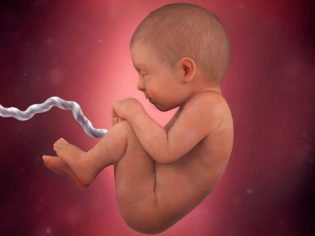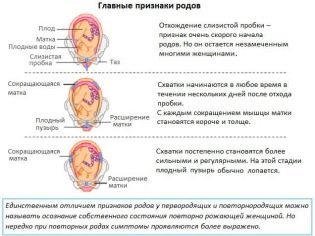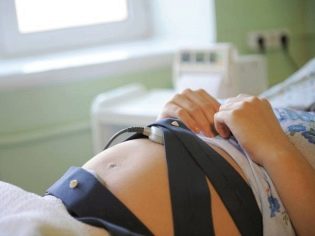39 week of pregnancy: what happens to the fetus and the expectant mother?
When the gestation period is approaching 39 weeks, the expectant mother is in constant readiness. Birth can begin at any moment. This event is very welcome, but causing fear and excitement - how it goes. What happens to the baby and his mother this week, we will tell in more detail.
How many months is it
The 39th week of pregnancy according to the calculations of the attending physician and the ultrasound data is the obstetric standard for calculating the gestation period. It differs from real by approximately 2 weeks, since the starting point is the first day of the last before conceiving menstruation. Thus, week 39 is 37 embryonic weeks.
Translated into normal calendar calculus, passed 8 months and 3 weeks or about 274 days. Until the expected date of birth, indicated in the exchange card of a pregnant woman, there are still about 7 days, but this does not mean that labor activity will start on the day indicated - this probability is not more than 6-7%.
According to statistics, all other births occur either before the DA, or later. At week 39, about 40% of women begin labor.
How was the baby?
For the time spent in the mother's womb, the baby has become quite big, he has learned a lot.
Most of the parameters on this term are purely individual, therefore Do not blindly focus on the average standards, your baby is now what it will be born very soon.
Weight and height
The weight of the fetus at 39 weeks usually exceeds 3 kilograms. There are especially "outstanding" kids, whose body weight is 4 kilograms and even more, and there are small and miniature boys and girls, whose weight this week barely falls short of 2900 grams.
In the embryonic period, all babies grew at approximately the same rate, and therefore a deviation from the average norms was considered an important diagnostic sign of the fetus.
Now the range of normal values is large: a three-kilogram baby, and one whose weight is above 4 kilograms, fits into the values of the norms caused by features of the course of this pregnancy and genetic predisposition - The child’s body build and body are inherited from their parents.
The growth of babies in the 39th week of pregnancy is more than 50 centimeters. Possible fluctuations of this parameter - from 48 centimeters to 58 centimeters. Estimated weight can be set by ultrasound with a small error.
It is rather difficult to measure height, because the coccyx-parietal size is not measured at this period - the baby has become large, only individual parts of his body can be measured.
Fetometry
An ultrasound scan at this time is not mandatory, but it can be performed at the request of the pregnant woman herself in a paid clinic or in consultation for medical reasons. Also, ultrasound is done on admission to the maternity hospital in a planned manner.
When scanning with ultrasonic waves, the key sizes of the baby are determined. 39 week peculiar to the following average rates:
- bipariented head size - 94-95 mm (allowable range - 86-102 mm);
- frontal-occipital head size - 119 mm (allowable range 108-129 mm);
- femur length - 73-74 mm (range of norms from 68 to 79 mm);
- the length of the bones of the tibia is 65-66 mm (the normal range is from 61 to 71 mm);
- humerus length - 64-65 mm (values from 60 to 70 mm are acceptable);
- the length of the bones of the forearm - 56-57 mm (valid from 51 to 60 mm);
- tummy circumference - 336-342 mm.
The baby continues to grow, but not as intensively as a month earlier. If childbirth does not occur this week, then by 39-40 week of pregnancy the baby will gain no more than 50-100 grams in weight and no more than 0.5 -1 cm in height.
Nervous system
The nervous system of the fetus at week 39 continues its formation and development, unlike other systems of the body that have already been formed and work almost like adults. The central nervous system (brain and spinal cord) is physically formed, but their functions continue to improve. While sensitive analyzers, glial tissue and those parts of the facial nerve that are responsible for sucking are mature. The rest has yet to learn, and this process will be continuous after birth.
The baby already has 70 reflex movements, which nature provides for human survival - he will close his eyes in response to a bright light, swallow a motion when food or saliva gets in his mouth, shudder at a sharp loud sound, curl up when there is pain in the abdominal region and etc.
Every day in the brain and the system of branched nerve endings of the fetus all new neural connections are laid, new neuromuscular reactions appear. Already, the crumbs brain "controls" the movement of limbs, wakefulness and sleep, and even emotions. The baby in the womb feels good about the mood of the mother, can worry and rejoice with her.
The development of internal organs
The internal organs are fully developed, the mother can not worry that some of them have not matured. At week 39, even the lungs are considered ripe. They accumulated the necessary amount of surfactant - a substance necessary for independent breathing, without which the alveoli would stick together among themselves, interfering with the opening of the lungs immediately after birth.
The digestive system of the baby works as it should:
- the stomach digests the amniotic fluid swallowed by the little one;
- all the necessary enzymes for the digestion of food in a child are produced independently;
- in the intestine there are villi that are needed for the absorption of beneficial substances;
- In the rectum a considerable amount of green-black feces has accumulated, which is called primordial meconium. After birth, the baby will be emptied by it, thus the intestines will enter the normal rhythm of work in the new living conditions.
The bladder of the child and his kidneys function as they would do after his birth - a crumb pissing about once an hour. The heart beats at a frequency of about 157 beats per minute. The genitals are fully formed, the testicles of most boys have descended into the scrotum.
Stirrings
The movements of this week, women feel less. But in their severity, they become more painful. The reasons for this - in reducing the amount of amniotic fluid and the location of the baby. He now occupies all free space of the uterus, and the uterus itself occupies almost the entire space of the abdominal cavity.
The uterine walls tightly encircle the body of a child, which is why perturbations are felt painfully. The amount of movement decreases somewhat due to the fact that there is practically no space left for the child to move. It is grouped, tightly pressing the legs and arms to fit in the uterus.
At week 39, something new appears in his posture - he presses his chin tight against his chest. This posture helps him to be more “compact”.
Some calm in the stomach of a woman should not scare. If in 12 hours she manages to fix 10 or more different movements, including light movements, then there are no reasons for unrest.
Lack of movement for 5-6 hours is a reason for going to the doctor. Active and abrupt movements, which have not subsided for a long time, can also be a sign of hypoxia. Medical consultation is required.
Appearance
Baby on week 39 looks plump and plump. During the third trimester, he was actively accumulating subcutaneous fat. Thanks to him, the skin has ceased to be red-lilac, numerous wrinkles that covered the body of the baby earlier completely smoothed out.
Fluff lanugo also disappeared, it is no longer necessary. In rare cases, children are born with lanugo, which is not completely lost - the skin of the skin in this case disappears during the first weeks of life.
White and thick original lubricant, which was covered baby, also no longer needed, it remains as protection only in the groin area and in the folds of the arms and legs, that is, where there is a chance of mechanical rubbing.
The features of the baby are fully formed. His mimic muscles are very developed, which give him the opportunity to build a variety of grimaces and faces.
The genitals of boys and girls, as well as the mammary glands of babies of both sexes, look somewhat swollen on this period. This is due to the strong effects of estrogen - hormones, which are produced before childbirth in the body of the future mother.
Many babies in 39 obstetric weeks have thick hair on their heads. But compulsory scalp hair is not considered. This is an individual trait.
Sense organs
A baby at 39 weeks is theoretically able to distinguish objects at a distance of up to 30 centimeters. But for this he must first be born. In the meantime, he opens his eyes, sees the outlines, the light spots, well distinguishes darkness from light.
Hearing crumbs at this time is more perfect - it was formed before sight and has already managed to reach a certain level. Baby now hears mother well - her heart, the work of the intestines, the rumble of blood running through the arteries.
He knows her voice, as well as the voices of the pope and other households who are always nearby. Loud unexpected sounds, for example, the alarm bell, responds with fear.
Tastes the fetus nuances well - the receptors on its tongue and the inner surface of the cheeks work to the full. The smells of the baby are not yet available, because he has no nasal breathing yet. However, all the necessary receptors are already available, and immediately after the birth of the baby will begin to feel the smells, and soon to distinguish them. First, he will study the smell of mother and her milk and will not confuse him with anything else.
Immunity
The immune system is fully formed. She has already begun to work, but still remains very weak. Without additional protection, the baby may die after giving birth, because from the sterile environment in which it resides, it will fall into a world full of bacteria and viruses.
To eliminate this possibility, nature has provided for the exchange of antibodies. Mom, through her blood, gives the baby antibodies to the diseases that she herself has suffered, if immunity is formed against them, as well as to the illnesses from which she was vaccinated.
Congenital immunity is stronger in children who are not in a hurry to be born. An aging placenta gradually loses its barrier function, and more antibodies pass through it.
Maternal protection will not be permanent. It protects the baby only for several months after its birth. Then, their own immune defenses will begin to grow stronger and “learn” from diseases and vaccines.
What does mom feel?
Feelings of the future mother at week 39 cannot be called light and comfortable. The stomach is so big that it becomes difficult for a woman to breathe, it is difficult for her to do her daily activities and move.Some relief comes only when the stomach sinks. For many at this time, he has already dropped, the rest is coming in the very next few days.
Pain sensations
Pain at week 39 is very varied. Most often, future mothers complain that pulling the lower back, pain and "lumbago" are in the coccyx, pubic bone, aching and back aches. Unpleasant soreness in the back and lower back - the consequences of a shift in the center of gravity due to a grown and heavy abdomen. To balance the body of a pregnant woman, the back muscles have to work hard.
Pain in the perineum and in the pubic area is a consequence of the action of the hormone-relaxin, which is produced in large quantities in the later stages of pregnancy to soften the pelvic bones, ligaments, and the pubic joint.
The process of divergence is accompanied by pain, which increases with walking, when trying to get out of the horizontal position of the body, when climbing the stairs.
If symphysitis is not diagnosed, there is nothing to worry about. Pain will pass after childbirth, and childbirth is not far off. In the meantime, relieve pain will help "No-shpa».
Many women claim that head 39 often hurts at week 39. This may be due to the nervous factor, because the expectant mother is nervous in anticipation of the onset of labor. Headache also accompanies hypertension - a condition in which blood pressure on the walls of blood vessels increases. If you are prone to hypertension, you should monitor your blood pressure twice a day. With an increase in blood pressure level, you should call an ambulance and agree to hospitalization.
Breast on this obstetric week hurts because of the restructuring in the body, which "started" hormones. Previously, the process of carrying a baby answered progesterone, now it is replaced by estrogens. Colostrum may leak from the breast. Because of false, training contractions, pain in the abdomen may be disturbing, in character resembling a nagging sensation as during menstruation.
Allotment
Most pregnant women at 39 obstetric weeks have a slight increase in the amount of vaginal secretions. Normal are the discharge, no odor, sparse texture, light or transparent.
If a woman notices a watery discharge on a daily pant or underwear, this may indicate a leakage of amniotic fluid. To determine exactly whether water is leaking, you can use pharmacy amniotesta, as well as at the reception at the gynecologist.
Water leaks can not be ignored, you need to see a doctor as soon as possible. Waters can move away entirely. The rupture is abundant in this case; it is impossible to confuse it with anything else. Pay attention to the color of water. If they are transparent, then there is no reason to worry.
A greenish tint is a sign of unhappiness of the fetus, at which the intrauterine defecation occurred. This happens when entwining the umbilical cord, with hypoxia. In any case, the leakage and discharge of water is a reason to go to the hospital.
Mucous discharge clots of pink, cream-colored, interspersed with streaks of blood can speak about the discharge of the mucous membrane of the cork, which during the entire pregnancy covered the cervical canal, protecting the fetus and uterus from bacteria and foreign bodies.
Cork discharge is considered a sign that labor will begin soon. If the cork does not go away, then the time has not come yet. The cork can go off in whole or in parts for several days. If she has departed, you should go to the hospital, even if the contractions have not yet begun.
White discharge with a sour odor can talk about the development of thrush against the background of changed hormonal levels. Greenish and gray discharge most often "signals" about the presence of infection in the genital tract.
Thrush and infections, if time permits, should always be cured before giving birth. If you do not have time, you will have to give birth in the observation department, and the risk of infection of the baby will be high.
Digestion
Digestive problems - a separate topic for conversation. At week 39, a woman can be tormented by the full range of gastroenterological "problems" - diarrhea, nausea, severe heartburn, constipation, and even vomiting. The reason lies not even in the diet or lifestyle, but in a large and heavy uterus, which mechanically squeezes the organs of the digestive system.
The stomach is compressed from the bottom, which leads to the reflux of gastric juice in the esophagus, it causes heartburn, even with proper and balanced diet.
The gallbladder is pressed from two sides, the outflow of bile is disturbed, with the result that the woman becomes sick and nauseated, there are pains in the right side and right hypochondrium. Intestinal loops are retracted by the uterus, squeezed along the front line, as a result - loose stools, gas, constipation.
Some women begin to suffer from dehydration amid diarrhea. Diarrhea is often the body "cleansed" before childbirth, removes from itself all that is superfluous and completely unnecessary during childbirth.
A small percentage of pregnant women states that at week 39 an unusual appetite appeared. The rest of the appetite decreases.
Pregnant weight this week may be reduced. Hormones, which are now preparing the female body for childbirth, contribute to the removal of intercellular fluid from the tissues, due to this, as well as due to the "thinner" placenta and decreased amount of water, a woman becomes 0.5-1 kg lighter.
Immunity
Against the background of global changes in the body, a woman’s immunity may temporarily weaken, so a cold, an acute respiratory viral infection, acute respiratory infections or flu in the last weeks of a baby’s birth is not so rare.
Many women complain of frequent urination and pain in the process of emptying the bladder. Such cystitis before childbirth is often also the result of a weak immune defense.
The urge to urinate frequently without pain and pain in the process is a feature of late gestation. Baby head presses on the bladder and nerve endings. After childbirth, these unpleasant symptoms will pass.
Possible problems
The condition of a woman at week 39 can be quite unsightly. Insomnia, dizziness, fatigue and weakness are added to digestive problems. Hormones-estrogens and quite understandable excitement and experiences that a woman is on the eve of childbirth are to blame for everything.
Lack of sleep leads to the fact that a woman experiences weakness during the day, she constantly wants to sleep. Mood changes like the weather by the sea - tearfulness, irritability, hypersensitivity to everything that happens makes a woman very vulnerable.
The head is spinning and hurts, constantly waiting for the symptoms, indicating the beginning of labor, hassled. In varying degrees, these manifestations at week 39 are characteristic of all pregnant women. In addition to these, more serious complications can occur.
Gestosis
Such a complication can develop at any time, and it is considered dangerous to the life of the baby and his mother. Symptoms may appear edema, and may be hidden.
The causes of preeclampsia are not fully understood. A woman can examine the swelling of the legs and arms, as well as the face and the front abdominal wall herself, but only a doctor can establish the fact of hidden, internal edema, which is the most dangerous.
If you suspect that your legs are swollen (traces of gum socks remain, worn and previously comfortable shoes have become small) or hands (wedding ring bumps in) It is necessary to inform the doctor about this.
If the swelling does not go away after a few hours after waking up, if a woman is diagnosed with protein in the urine, high blood pressure, then she will be required to go to the hospital and are more likely to offer delivery by stimulating childbirth or caesarean section (this will depend on features of pregnancy).
Hemorrhoids and varicose veins
Uterine pressure on the lower veins at week 39 can lead to unpleasant and very painful symptoms of hemorrhoids. Impaired blood supply to hemorrhoidal veins leads to the formation of nodes, sometimes - with their subsequent loss outside the anus.
Most likely, a woman will not be able to fully treat hemorrhoids before delivery, especially since labor leads to the return of symptoms. To get rid of pain and anal bleeding a woman can now with the help of medicines that the doctor will approve. Cure the disease until the end will be after childbirth.
Varicose veins in the legs have the same causes as the appearance of hemorrhoids. Pregnant women are allowed to take venotonics in ointments and gels, and also to apply a non-elastic bandage from an elastic bandage.
Allergy
The causes of allergies on the eve of childbirth are not completely understood by medicine. Most likely, the same female sex hormones that trigger several processes that are important for preparing for childbirth are the cause of the manifestation or the initial appearance of an allergic reaction to something.
If the allergy manifested itself at week 39, you need to talk to your doctor about it. Allergic runny nose and cough are well removed by antihistamines, their use in the third trimester is not contraindicated, but this possibility must be discussed with the doctor.
It is also advisable to enlist the support of an allergist who will give a certificate stating that a woman’s runny nose is allergic.so that when they are hospitalized in the maternity hospital, the staff do not have any suspicion of infection, and the woman is not placed in the observation unit.
Placenta and water
The normal thickness of the placenta for 39 weeks is 33-34 mm. The "baby seat" still continues to feed the baby, to provide him with the supply of nutrients and oxygen from the mother's blood, the excretion of the products of his vital activity, but the placenta quite naturally ages, decreases in mass and volume. She begins to cope worse with the responsibilities assigned to her by nature. The degree of maturity of the placenta at this time - the third.
The amniotic fluid index, which is used to determine the amount of amniotic fluid, at week 39 is on average 127-226 mm. Severe water deficiency is considered to be less than 63 mm, and polyhydration at this time is indicated if the index exceeds 226 mm.
Presentation of the fetus
The baby is now in the position in which childbirth will find him. Most of the children are in the mainstream presentation. Head to week 39 is usually lowered and pressed to the exit of the small pelvis.
If the head is not lowered yet, this will be reported during the ultrasound. It can descend in primiparas long before childbirth, and in multiparous women it can descend just before birth
If the baby is now in pelvic presentation (adjacent to the exit of the small pelvis) or lying across the uterine cavity (in transverse presentation), then most likely his position will not change, because in the uterus there is no more room for free coups of a large fetus. The woman will be scheduled for a scheduled caesarean section. With high probability, she has already been appointed exactly 39 weeks or a week later.
Signs of imminent labor
In pregnancy, twins birth at 38-39 week - the most likely outcome of events. With singleton pregnancy, the probability of onset of labor now is just over 40%. However, these are only statistics figures, in fact, the child will appear when he is fully prepared for this.
Women at this time are concerned about the question of whether they can find out the signs of the onset of labor. Let's help them figure it out.
Primiparous
If the pregnancy is the first, then women usually have more time to get to the maternity hospital safely, because the birth process in them is slower. At the first full-term pregnancy, forecasts are ungrateful.
Symptoms, popularly known as forerunners, can begin long before the actual onset of labor. So, the belly of a primiparous person often goes down several weeks before the baby is born, therefore the omission of the abdomen cannot be considered the absolute sign of beginning labor.
Much more informative signs - discharge of mucus plug and amniotic fluid. The leakage of amniotic fluid without contractions is also a reason to be sent to the maternity hospital, since the water level can reach the minimum critical level, and the dry period will not benefit the child.
Contractions are the undisputed beginning of labor. When they begin, no one will say, but the real contractions are very different from the false, training, which may occur several weeks before the onset of labor.
When training fights pulling back pain, lower abdomen, the periodic tone of the uterus does not have a certain frequency and cyclicality, they quickly pass if the woman lies down to rest.
With true contractions, their frequency and duration increase. In the maternity hospital should be sent when contractions are repeated every 10 minutes.
Many women before childbirth begin to actively get out, to clean the house. So manifests the instinct of "nesting". But to consider it as a sign of a speedy birth cannot be reliably. Often, before childbirth for a couple of days, a woman has diarrhea. This is a cleansing of the body, it is necessary and quite natural.
Secondary
Harbingers of childbirth in multiparous women are the same, but they flow a little faster. Thus, a woman’s abdomen during a second or third pregnancy may drop just before the birth, and training bouts start 3-4 days before the birth of the baby.
With repeated delivery, it is important to notice the true contractions in time and to go to the obstetric institution as soon as possible. because women, who have already had the opportunity to give birth naturally, open the cervix, its internal and external os, sometimes at the same time, which increases the likelihood of fast, rapid delivery.
As in the case of the first birth, in the maternity hospital you need to go without waiting for the fights, if the water has withdrawn. In the absence of an independent labor activity, doctors will be able, with the use of medications, to cause contractions and stimulate labor.
Stimulation is indicated only for pregnant women who have no contraindications to natural childbirth.
According to reviews, many expectant mothers feel anxiety before the second or third childbirth, inability to sit in one place, they are thrown into heat and cold, the temperature may rise slightly to 37.0 degrees or slightly higher.
How to speed up childbirth?
The desire of a woman to give birth as soon as possible at week 39 is quite understandable, because the expectant mother is very tired of wearing the baby, she is in pain, I want to get enough sleep. Therefore, the question of how to accelerate childbirth in a full-term pregnancy is one of the most burning. One can argue about the expediency of these actions for a long time, but it is obvious that the baby who does not want to come into the world for the time being will not “ask” outside, no matter how much the future mother tries.
There are several proven ways of generations of women. The most effective is the so-called "Mudeterapiya." Even doctors recognize that sex helps the female body to prepare for childbirth. Orgasm stimulates the uterine muscles, and semen contains prostaglandins - hormones that promote relaxation, smoothing and softening of the cervix - a necessary condition for the onset of normal labor.
Sex at week 39 is contraindicated only in some cases - when a mucus plug comes out, if the partner has an infection, as well as when there are individual threatening factors that the attending physician will surely tell the woman.
To increase the chances of the onset of labor, many women practice squats, active walks on foot in the fresh air or up the stairs, special gymnastics, in which the muscles of the perineum are trained.
Doubtful ways include artificial diarrhea that women cause by drinking magnesia or castor oil. Both magnesia and castorca are strong laxatives. A future mother may overdo it and cause indomitable diarrhea.
Tips to drink champagne or red wine do not hold water. Alcohol expands blood vessels. This can in no way cause contractions or the discharge of amniotic fluid, but it can harm the baby, because it will receive a dose of hot crumbs with maternal blood.
If childbirth begins after alcohol intake (solely by coincidence of circumstances!), Alcohol in the blood increases the likelihood of bleeding during the birth of the baby and the afterbirth, because blood clotting from intoxicating drinks decreases.
It is also necessary to be wary of advice to drink coffee - coffee increases blood pressure, and hypertension at the 39th week of pregnancy can cause a lot of trouble for both the woman and the midwives who will take part in her labor.
Analyzes and surveys
At the 39th obstetric week, no new diagnostic examinations are performed for the woman. If she is still at home, then a regular visit to the antenatal clinic for an appointment with an obstetrician-gynecologist is considered mandatory.
A pregnant woman is weighed within the reception, evaluating weight gain or weight loss, measures the height of the uterus floor, and examines her arms and legs for edema in order to detect possible late toxicosis in time.
If the doctor has doubts about the condition of the fetus, if the pregnancy has proceeded with some complications, a woman at this reception, who may become extreme at this pregnancy, is given a cardiotogram CTG to assess the baby's heartbeat and his physical activity.
Ultrasound and USDG prescribed for indications. The doctor may also conduct a gynecological examination on the chair in order to assess the condition of the cervix, its readiness for childbirth, the likely discovery.
Mandatory on the 39th obstetric week is a urinalysis, as well as a blood clotting test - a coagulogram, if it was not performed a week earlier.
Coagulability factors must be investigated to select the correct tactics of childbirth, precluding the occurrence of extensive bleeding.
Recommendations
Nutrition
Women this week are not recommended to drink a lot of milk, eat cottage cheese and take calcium supplements. An excess of this mineral will lead to the rapid hardening of the bones of the fetal skull, which will adversely affect the generic process, complicate them.
To slightly reduce the negative manifestations of the gastrointestinal tract, At this time, meat and fish dishes, pastries and sweets should be avoided. It is best to eat portions, salads, fresh and steamed vegetables and fruits 5-6 times a day in small portions. Such food will be digested and digested faster.
Walking
Walking pregnant can and should be, regardless of the duration of pregnancy. The only thing worth taking care of at week 39, going to the promenade, is not to go far from home, so that childbirth will not be taken by surprise in a remote foreign area.
You should always have a charged mobile phone and documents with you.that are needed for the maternity hospital in case a woman is sent there to the “ambulance” right from the walk - this is a passport, a medical policy, an exchange card with all analyzes and a birth certificate.
Mood
The child perfectly feels everything that mom feels, therefore, despite the excitement and feelings, fatigue and constant expectation, the woman needs to calm down and pull herself together. By the time of birth, both - mother and baby - must be rested, full of strength and energy, because both will have to work hard.
If there is a need for sedatives, it is worth discussing the possibility of taking a particular drug with your doctor. Herbal medicines with a slight sedative effect are usually resolved late.
Things in the maternity hospital
If the bag has not yet been collected, this must be done this week. They take with them to the maternity hospital clothes for mothers and babies, hygiene items, baby diapers and special disposable underwear for women in childbirth, disposable diapers, a cup and a spoon, and a mobile phone charger. If you need anything else, relatives or friends can bring it to the obstetric institution.
Diseases and drugs
The future mother needs to be especially vigilant - now more than ever there is a high probability of catching a seasonal viral infection, to catch a cold. If this happens, do not get upset - most drugs are already allowed in the third trimester, but will have to give birth in the infectious diseases ward of the maternity hospital. Although this is not particularly scary.
About what happens at the 39th week of pregnancy, see the following video.
























































